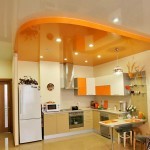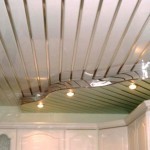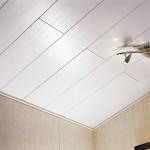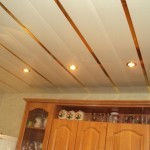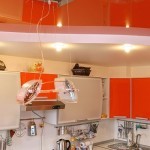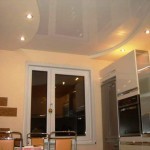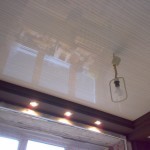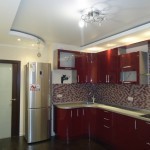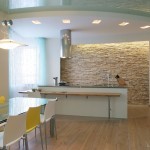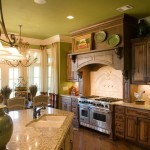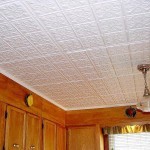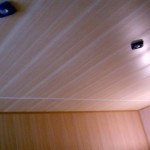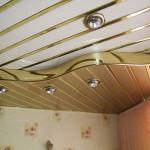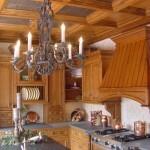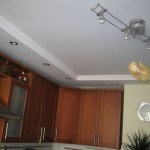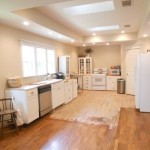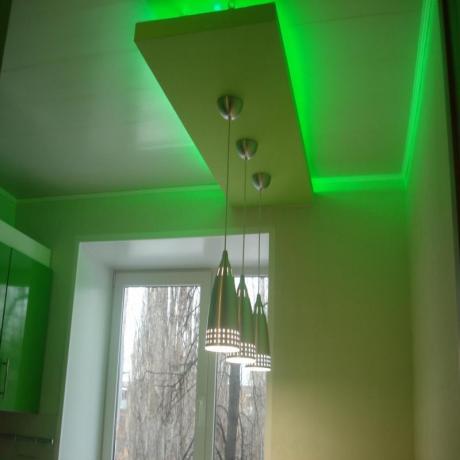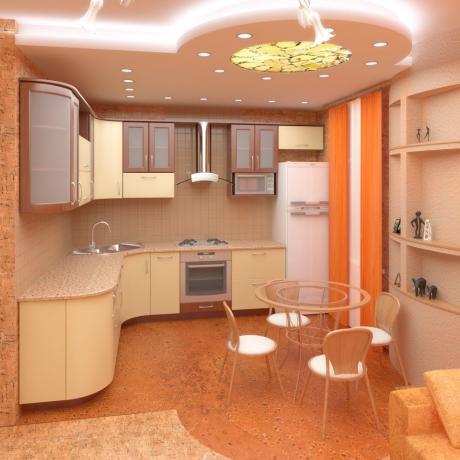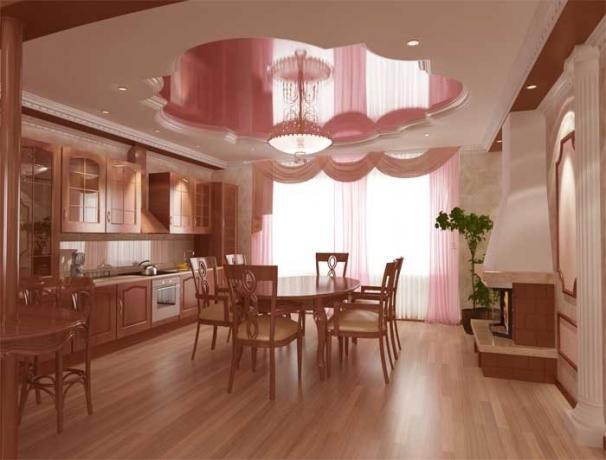Content
-
1 Ceiling finishes
- 1.1 Suspended ceiling
- 1.2 Stretch ceiling
- 1.3 Pasting with tiles, wallpaper, decorative plaster
- 2 Painting technology
-
3 Materials for work
- 3.1 Leveling mixtures
- 3.2 Finishing putties
- 4 Conclusion
Repair work includes a fairly large set of operations. One of the most difficult works is the leveling of the ceiling space. That is why almost every year new materials and technologies are invented and successfully introduced, which are used for these purposes.
Asking the question - how to decorate the ceiling in the kitchen, you need, first of all, to consider all the types of such finishes that exist today. The variety of modern types of materials and technologies that are used for such purposes does not make the choice easy.

Photo - an example of ceiling decoration.
It is quite difficult for a layman to deal with such a variety of new materials and technologies. For this, there is a classification that will help to understand the question of how to decorate the ceiling in the kitchen.
Ceiling finishes

Photo of painting the ceiling.
Of the existing types, the following can be distinguished:
- whitewashing or painting,
- dropped ceilings,
- stretch ceiling,
- wallpapering,
- finishing with liquid wallpaper and decorative plaster,
- pasting with ceiling tiles.
Suspended ceiling

The photo shows the installation of a false ceiling.
The most modern are suspended ceiling options for the kitchen. Their main advantage is the expedited procedure for leveling the horizon line. It is carried out with a frame structure attached to the base ceiling.
Wooden bars or metal profiles are used as a frame. Finishing elements on the frame can be of a wide variety of shapes and materials.
Important. A similar option is false ceilings.
The main difference is the rigid fastening of the frame to the base ceiling, while the suspended versions have a suspension-shaped fastening.
Stretch ceiling

Photo of a stretch ceiling.
This rather new look is still the same skeleton. Unlike hanging and hemmed options, fabric or film is used as a finishing element. The main advantage is considered to be high moisture resistance and fire safety.
In addition, polyester fabrics and PVC films used as finishing elements can be produced in a wide range of colors. The disadvantages include a rather complicated installation, high cost and insufficient resistance of polymer films and fabrics to temperature extremes.
Such options for finishing the ceiling in the kitchen and in the bathroom can lead to sagging of the film or fabric during temperature changes.
Pasting with tiles, wallpaper, decorative plaster

In the photo - ceiling tiles.
This variety is the most affordable option. However, the main difficulty lies in leveling the horizon. Before decorating the ceiling in the kitchen with tiles, wallpaper or decorative plaster, you must carefully level the horizon.
Despite the many modern materials and technologies, such a decoration of ceilings in the kitchen, especially with the use of simple whitewashing and painting with water-based paints, is used quite often.
The reason for this popularity is the relative simplicity of the process, availability and relatively low cost of materials. In addition, such a finish is easy to do with your own hands.
Painting technology
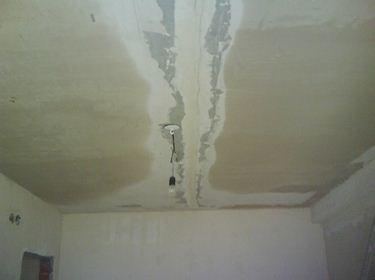
Photo - ceiling alignment.
- First of all, the area is being prepared.
Such preparation consists in cleaning the surface:- the old finish is removed with a wet brush;
- sagging and irregularities are removed with abrasive materials;
- to remove old paint, you can use special removers, which are applied to the surface with a roller and removed after a certain period;
- After the surface has dried, it is treated with a primer. Such processing is needed for better adhesion of the finishing compounds to the ceiling surface;
- After that, you can proceed to the direct leveling of the plane.
Materials for work
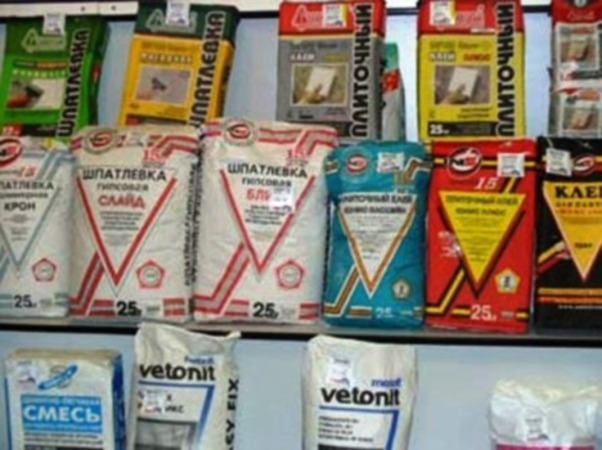
Modern leveling compounds.
Leveling mixtures
Leveling compounds for ceilings and walls are available dry. They are completely ready for use. Before use, you just need to add water in a certain proportion. The quality of the mixture will largely depend on the thoroughness of the mixing.
For the preparation of the composition, as a rule, a construction mixer is used. The packaging of the mixtures contains instructions that describe the main technical characteristics.
Mixtures are classified according to the main binder.
Main connecting elements:
- Cement;
- Lime;
- Gypsum.
In addition to the basic binders, a combination of these can be used. So there are lime-cement mixtures. Compositions based on cement and lime are used for facade work and work in rooms with a high humidity content.
For interior decoration, as a rule, gypsum-based mixtures are used. Their advantage is a short setting time.
Attention!
To level out significant differences in height - over 1 cm - using starting plasters.
The main difference between starter plasters is a large filler fraction.
They can even out height differences up to 5 cm.
Finishing putties

The photo shows the application of the finishing putty.
After leveling with starting plasters, the surface is puttyed. The main purpose of the putty is to create a flat and smooth surface. Like plaster mixes, they differ in the basic binding material.
By analogy with plaster compositions, they can be cement, gypsum, lime. In addition, recently, putty compositions based on polymer resins are often used.
A characteristic feature of gypsum putties is the time of their suitability for use. That is, such a putty must be used for a certain time. Modern putty compounds have a pot life that varies from 20 to 90 minutes.
After the putty has dried, the surface of the ceiling space is ready for further finishing. Such a surface on the kitchen can be painted, whitewashed, ceiling tiles or decorative plaster can be applied.
Conclusion
Longest stay on kitchen without repair stretch and false ceilings, as well as ceiling tiles. Suspended ceilings will also protect the room from leaks. More details about different types of finishes and their properties are in the video for the article.
Gallery
